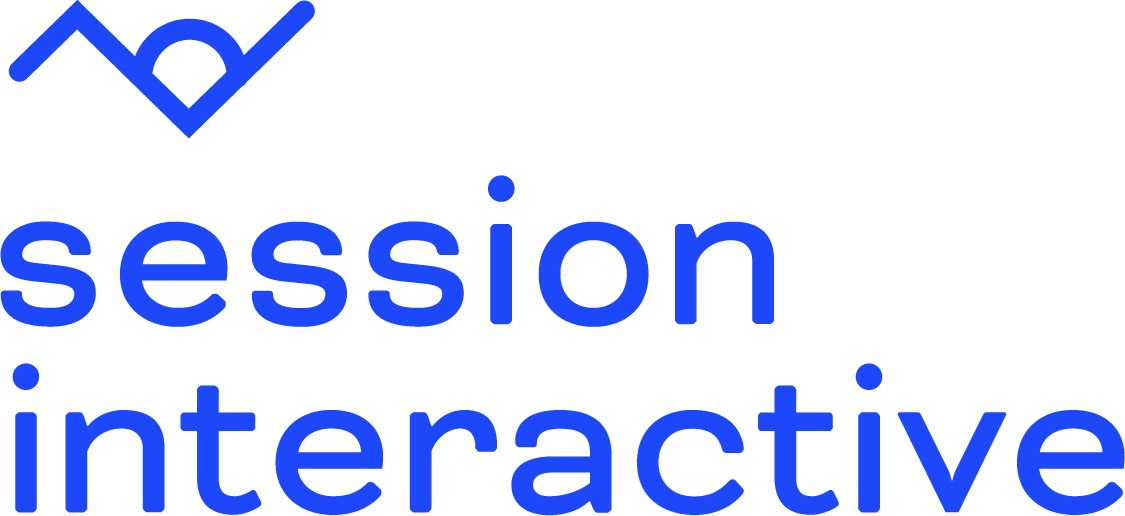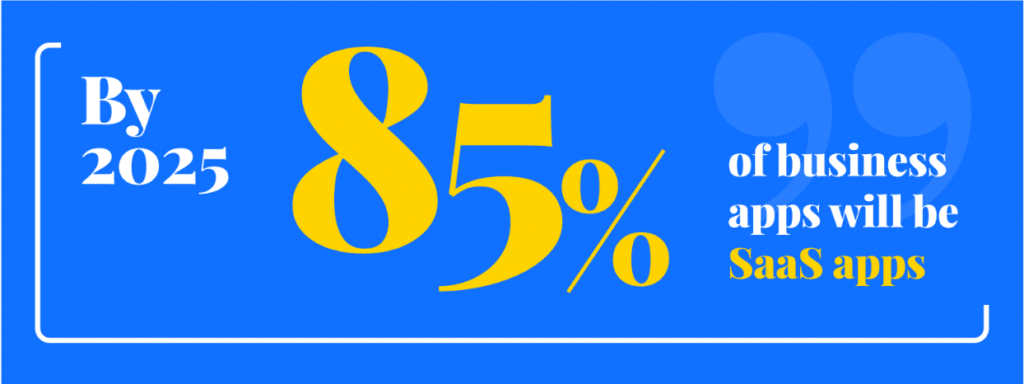What SEO strategy for SaaS companies performs the best?
It’s an important question. The marketplace for SaaS products is becoming more and more competitive. It’s forecasted that by 2025, 85% of business apps will be SaaS apps. Will yours be visible in search?
We’re here to help. We’ve rounded up our experiences working with SaaS SEO clients to present actionable tips to help you start climbing search rankings.
In this guide:
As an SEO agency for SaaS companies, we have helped companies like yours find their audience in search. We help SaaS companies provide all the resources needed for a potential customer to understand how they will use the product and how it will benefit them. We’ll help you put your value proposition in search-friendly terms and reorganize your site to nurture your most relevant traffic to conversion.
We understand that with SaaS, acquisition is only half the battle. Customer retention is just as important. We’ll help you build and execute a content strategy that boosts search visibility and customer success at the same time. It’s crucial to be a resource your customers can trust with all questions related to your product.
SaaS SEO Strategy 101
Having a well-crafted SEO strategy helps you sustainable growth. By optimizing your online presence, you can attract and convert the right audience, improving the efficiency of your marketing spending.
In this section, we’ll cover the fundamental aspects of SaaS SEO, from what it is to how to build a comprehensive strategy that aligns with your business goals.
What Is SaaS SEO?
SaaS SEO is the process of improving your SaaS company’s performance on search engines like Google to improve the relevance and quality of your organic traffic. Search engine optimization can elevate your brand’s visibility, drive targeted traffic to your website, and increase conversion rates. The goal is to ensure that your business appears at the top of the search results when potential customers search for keywords that indicate intent to learn or buy.
What Is an SEO Strategy?
An SEO strategy is a detailed plan aimed at improving your website’s search engine rankings to get more organic traffic. This is especially relevant for SaaS companies because they need long-term growth and customer acquisition to grow. A solid SEO strategy enhances online visibility and supports your broader digital marketing strategy for SaaS companies.
How to Build a SaaS SEO Strategy
Crafting a successful SaaS SEO strategy is essential for driving organic growth and ensuring your product reaches the right audience. An effective strategy will not only boost your search engine rankings but also enhance the overall user experience on your website. In this section, we’ll walk you through the critical steps to build a robust SEO strategy tailored to SaaS companies. From thorough keyword research to continuous monitoring and improvement, each step plays a vital role in achieving your SEO goals and sustaining long-term success.
1. Research
Research forms the foundation of your SaaS SEO strategy. Start by identifying the keywords and phrases that your target audience uses when searching for solutions similar to yours. Tools like SEMrush and Ahrefs can help you find high-volume, low-competition keywords. Additionally, analyze your competitors’ SEO tactics to uncover opportunities and gaps in your own strategy. Look into keyword difficulty, search intent, and competitor backlinks.
2. Goal-Setting
Setting clear, measurable goals is essential for any SaaS SEO strategy. Your goals should align with your overall business objectives, be measurable, and attainable. For example, you might aim to increase organic traffic by 30% in the next six months or achieve a top-three ranking for a set of targeted keywords within the year. Having these goals will guide your actions and let you measure success precisely.
3. Planning
Develop a comprehensive roadmap to achieve the goals you set. This includes creating a content calendar, identifying key milestones, and allocating resources. Make sure to plan for regular content updates, technical SEO audits, and backlink-building campaigns. Prioritize tasks based on their impact and feasibility, ensuring that your team has clear responsibilities and timelines to follow.
4. Execution
Create high-quality, valuable content that addresses your audience’s pain points and questions. Implement on-page SEO techniques like optimizing meta tags, headers, and keyword usage. Use tools to streamline the execution process and ensure each action aligns with your set goals.
5. Monitoring and Improvement
SEO is not a one-time task but an ongoing process. Continuously monitor your performance using analytics tools such as Google Analytics and Search Console. Track key metrics like organic traffic, bounce rates, and keyword rankings. Regularly review your strategy and make data-driven adjustments to improve performance. Stay updated with the latest SEO trends and algorithm changes to keep your strategy effective.
SEO Best Practices for SaaS Companies
Adhering to these best practices will help you attract and convert visitors into loyal customers. Below, we’ll outline the fundamental pillars for a successful SaaS SEO strategy.
Technical SEO
Properly optimized technical elements are crucial for improving your site’s visibility and performance. Make your website easier for search engines to understand and rank with these tips.
- Help Google Crawl and Index Your Web Pages. Ensure your site’s robots.txt file and XML sitemap are correctly configured to guide search engines. For example, a SaaS company offering project management tools should have an updated XML sitemap that groups project management product pages and blog posts together.
- Make Your Site Fast and Accessible. Page speed and accessibility are essential for user experience and SEO. Use tools like Google PageSpeed Insights to find ways to boost load times. Make sure you’re using the latest accessibility best practices.
- Ensure a Logical Site Architecture. A well-organized site architecture helps search engines understand the hierarchy and importance of your content. For example, a SaaS company might categorize their site by solutions like “CRM,” “Marketing Automation,” and “Customer Support,” each with sub-pages detailing features and case studies.
Keyword Research
Effective keyword research identifies terms and phrases your target audience uses. This step is vital for aligning your content with what potential customers are searching for.
- Understand Keyword Relevance & Intent. Focus on keywords with clear intent to use your services. If you offer cloud storage, you could target keywords around specific features like automated backup to attract visitors with purchase intent.
- Identify Core Product Keywords. Pinpoint keywords directly related to your primary offerings. For instance, a SaaS invoicing solution should emphasize terms like “online invoicing software” and “automated billing tool.”
- Align Keywords with Sales Funnel. Map keywords to different stages of your sales funnel. An analytics SaaS could use “best analytics tools” for the awareness stage and “buy analytics software” for the decision stage. Ensure that you are creating a journey to purchase from any starting point.
Content Strategy
A rigorous content strategy helps drive organic traffic and nurture leads through the sales funnel.
- Identify Your Target Audience. Understand who your ideal customers are and create content tailored to their needs. If you target small businesses, you might develop blog posts and guides focusing on low-cost software solutions and efficiency tips.
- Map Content Throughout Your Sales Funnel. Develop content for each stage of the buyer’s journey. For example, a cybersecurity firm could offer awareness-stage blogs on the importance of cybersecurity, consideration-stage whitepapers on choosing the right security solution, and decision-stage case studies showing product success.
- Monitor Performance for Additional Insights. Track your content’s performance using analytics tools. Adjust strategies based on data insights. An email marketing tool might discover that how-to tutorials generate more leads than generic listicles, prompting a shift in content focus.
Competitive Analysis
Analyzing competitors helps you understand what works in your industry and identify opportunities to outperform others.
- Identify Competitor Strategies. Examine what your competitors are doing well and areas where they fall short. If you find that competitors heavily invest in video tutorials, you could produce high-quality instructional content to compete.
- Uncover Keyword and Topical Gaps. Look for gaps in your competitors’ keyword targeting and content topics. For example, if a competitor lacks detailed content on a niche but essential feature, like integration capabilities, capitalize on this by creating in-depth resources.
- Inspect Backlink Sources. Review where competitors are getting their backlinks from and seek similar opportunities. A SaaS accounting software might notice competitors gaining backlinks from finance blogs and aim to secure guest posts or mentions on those sites.
SEO Tips & Ideas for SaaS Companies
Let’s get into tactics. Here are some actionable tips and ideas that can help you climb the search rankings that matter most.
1. Ensure Your Website Is Technically Sound
A technically optimized website is the backbone of effective SEO. This means ensuring proper crawling, rendering, and indexation by search engines. Your information architecture should be logical, with an intuitive user experience that keeps visitors engaged. Regularly audit your site to fix broken links, optimize page speeds, and ensure mobile responsiveness, making it easy for both users and search engines to navigate.
2. Establish Goals and Key Performance Indicators (KPIs)
Setting clear goals and KPIs is vital for measuring the success of your SEO efforts. These goals should align with your business objectives and achievable. For example, you might set a goal to increase organic traffic by 25% in six months, with KPIs like keyword rankings, organic sessions, and conversion rates to track progress.
3. Identify Your Ideal Customer Profile
Understanding your target audience is crucial for tailoring your SEO strategy. By identifying your Ideal Customer Profile (ICP), you can create content that speaks directly to their needs and pain points. For instance, if you’re targeting small businesses, your content should address their unique challenges, such as budget constraints or efficiency improvements.
4. Use Competitors for Keyword Insights
Competitor analysis can provide valuable insights into which keywords are driving traffic to similar SaaS companies. Tools like SEMrush or Ahrefs allow you to see the keywords your competitors rank for and identify opportunities. For example, if a competitor ranks well for “cloud project management software,” you might consider targeting related keywords like “best cloud project management tools.”
5. Map Keywords and Topics to Your Buyer Journey Stages
Aligning keywords and topics with the different stages of the buyer’s journey helps address search intent more effectively. For example, at the awareness stage, focus on educational content with keywords like “what is CRM software?” For the consideration stage, use terms like “top CRM features” and for the decision stage, target “buy CRM software.” This approach ensures your content meets the user’s needs at each stage.
6. Create Content that Connects with Your Ideal Customers
Creating content that resonates with your ideal customers helps build trust and loyalty. Focus on addressing their pain points and providing solutions. For instance, a SaaS company offering team collaboration tools might create blog posts about remote work challenges and how their software can solve them, making the content highly relevant and engaging for the target audience.
7. Track Keyword Rankings to Monitor Performance
Monitoring keyword rankings allows you to assess the effectiveness of your SEO efforts and make necessary adjustments. Tools like Google Search Console and SEMrush can help track how well your content is performing for targeted keywords. Regularly reviewing these rankings helps you identify areas for improvement and refine your search strategies accordingly.
8. Create a Content Distribution Plan Across Different Channels
Maximize your content’s reach by distributing it across various channels. Write, edit, and repurpose content for blogs, social media, email newsletters, and guest posts. For example, a SaaS company could turn a comprehensive blog post into a series of social media posts, an infographic, and an email campaign, thus broadening its visibility and attracting more organic traffic.
9. Build A Robust Knowledge Center For Your SaaS Product
Customer success during the demo phase can make or break a new SaaS customer. Plus, creating a knowledge center filled with tutorials, FAQs, and guides can significantly boost your SEO. This serves as an extensive resource for users and search engines alike, improving your site’s authority. A knowledge base that includes detailed articles on every feature of your software makes your site more useful, helping users find answers and keeping them engaged on the site longer.
Improve the Quality of Your Organic Traffic with Session Interactive
Ready to take your SaaS SEO strategy to the next level? Session Interactive specializes in helping SaaS companies like yours enhance their online presence and drive high-quality organic traffic. We find that a major barrier for SaaS companies is properly segmenting their offerings and clearly communicating their benefits. We have helped companies like yours overcome barriers and achieve sustainable growth with SEO.
Request a consultation with Session Interactive today and discover how their tailored strategies can transform your SEO efforts into measurable results.






